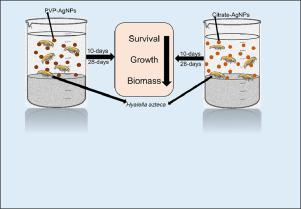Aquatic Toxicology ( IF 4.1 ) Pub Date : 2021-11-04 , DOI: 10.1016/j.aquatox.2021.106016 Joseph Kusi 1 , Kurt J Maier 1

|
Silver nanoparticles (AgNPs) are known to cause ecotoxic effects, but there are no existing derived ambient water quality criteria (AWQC) for these nanomaterials to protect freshwater aquatic life due to insufficient toxicological data. We exposed Hyalella azteca to silver nitrate, citrate-coated AgNPs (citrate-AgNPs), and polyvinylpyrrolidone-coated AgNPs (PVP-AgNPs) in a 10-day and 28-day water-only static renewal system with clean sand as a substrate for the amphipods and compared their point estimates with the United States Environmental Protection Agency (USEPA) AWQC for silver. We observed that all treatments decreased the survival, growth, and biomass of H. azteca, and the order of toxicity was AgNO3 > citrate-AgNPs > PVP-AgNPs. The LC50s of AgNO3, citrate-AgNPs, and PVP-AgNPs were 3.0, 9.6, and 296.0 µg total Ag L−1, respectively, for the acute exposure and 2.4, 3.2, and 61.4 µg total Ag L−1, respectively, for the chronic exposure. Acute and chronic EC20s of citrate-AgNPs ranged from 0.5 to 3.5 µg total Ag L−1 while that of PVP-AgNPs ranged from 31.2 to 175 µg total Ag L−1 for growth and biomass. Both Ag+ released from AgNPs and the nanoparticles contributed to the observed toxicity. The dissolution and toxicity of AgNPs were influenced by surface coating agents, particle size, and surface charge. Most point estimates for AgNPs were above AWQC for silver (4.1 µg L−1) and the lowest concentration (0.12 µg/L) at which Ag is expected to cause chronic adverse effects to freshwater aquatic life. Our study demonstrates that the current AWQC for silver, in general, is protective of freshwater aquatic life against AgNPs tested in the present study.
中文翻译:

评估银纳米颗粒对淡水片脚类动物(Hyalella azteca)的急性和慢性影响
已知银纳米粒子 (AgNPs) 会导致生态毒性影响,但由于毒理学数据不足,目前尚无这些纳米材料的衍生环境水质标准 (AWQC) 来保护淡水水生生物。我们将Hyalella azteca暴露于硝酸银、柠檬酸盐包覆的 AgNPs(柠檬酸盐-AgNPs)和聚乙烯吡咯烷酮包覆的 AgNPs(PVP-AgNPs)中,在 10 天和 28 天的纯水静态更新系统中,以干净的沙子为基材片脚类动物,并将它们的点估计与美国环境保护署 (USEPA) AWQC 的银进行比较。我们观察到所有处理都降低了H. azteca的存活、生长和生物量,毒性顺序为 AgNO 3 > 柠檬酸盐-AgNPs > PVP-AgNPs。AgNO 的 LC503,柠檬酸的AgNPs,和PVP-的AgNPs分别为3.0,9.6和296.0微克总银大号-1,分别为急性曝光和2.4,3.2,和61.4微克总银大号-1分别,对于慢性暴露. 柠檬酸盐-AgNPs 的急性和慢性 EC20 范围为 0.5 至 3.5 µg 总 Ag L -1而 PVP-AgNPs 的范围为 31.2 至 175 µg 总 Ag L -1用于生长和生物量。从 AgNPs 释放的Ag +和纳米颗粒都有助于观察到的毒性。AgNPs 的溶解和毒性受表面涂层剂、粒径和表面电荷的影响。AgNPs 的大多数点估计值高于银的 AWQC(4.1 µg L -1) 和最低浓度 (0.12 µg/L),在该浓度下 Ag 预计会对淡水水生生物造成慢性不利影响。我们的研究表明,目前银的 AWQC 总体上可以保护淡水水生生物免受本研究中测试的 AgNPs 的侵害。











































 京公网安备 11010802027423号
京公网安备 11010802027423号